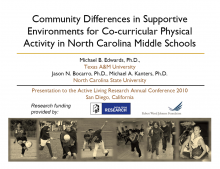We are pleased to announce an exciting new alliance between Active Living Research and GP RED to co-host and coordinate...
Community Differences in Supportive Environments for Co-curricular Physical Activity in North Carolina Middle Schools

Presentation at the 2010 Active Living Research Annual Conference
Background:
Adolescents who live in rural areas may be less likely to have access to supportive environments that promote physical activity than youth in more urban communities. For rural adolescents, schools represent an important setting for interventions to increase leisure-time physical activity (LTPA). Research has shown that well-designed extracurricular sport and physical activity programs in schools can improve the physical activity levels and social well-being of adolescents (Cohen et al., 2007; Wechsler et al., 2000). An investigation of disparities in access to school-sponsored LTPA environments is important to building an understanding of the opportunities rural children have to be physically active.
Objectives:
The objectives of this study were (1) to determine whether differences existed in access to supportive environments for extracurricular school physical activity for middle-school aged adolescents in North Carolina based on community type, and (2) examine how school composition, contextual financial resources, and social functioning influenced levels of supportive environments across communities.
Methods:
The units of analysis for this study were 325 public middle schools in North Carolina. Multiple sources of data were integrated. Data on schools and communities were collected through a self-administered web-based questionnaire adapted from School Health Policies and Program Study 2006 (SHPPS) with a response rate of 75%. Additional data were acquired from the National Center for Educational Statistics, North Carolina Department of Public Instruction, and the U.S. Census Bureau. Aggregating environmental supports (programs, facilities, inclusive policies, and partnerships), a composite index for environmental support (ES) for each school was created to use as the dependent variable (Young et al., 2007). Using multi-level modeling techniques to control for non-independence of schools clustered within school districts and to compare school/community-level (Level 1) and district-level (Level 2) influences on environmental support, random intercept models predicting environmental support from school compositional factors (i.e., school demographics, grade composition), community contextual resources (i.e., district per pupil expenditure, median household income) and collective social functioning (i.e., racial heterogeneity) were generated.
Results:
Study findings indicated that adolescents who lived in rural areas had fewer environmental supports for extracurricular physical activity at their schools. Fixed effects estimates (β = 3.73) of preliminary statistical models indicated that schools in rural communities (γ = -.563, SE = .224, p < .05) had significantly lower ES scores than schools in urban communities. There were no significant differences in ES scores between rural fringe (γ = -.043, SE = .212) or suburban (γ = -.303, SE = .247) schools and urban schools in this sample. The introduction of community type into the unconditional means model explained 23.4% of variance between school districts and less than 1% of variance between schools. This result suggested that place disparities in ES related to rural and urban differences may be more related to factors in school districts rather than in individual schools.
A theoretical model was estimated to evaluate explanatory variables and community type. Examination of the Type III tests of fixed effects (β = 3.42) showed that rural school deficits in ES compared to urban schools (γ = -.386, SE = .224) were no longer statistically significant. Controlling for all other variables in the model, on average, schools in this sample configured as extended elementary schools (γ = -.570, SE = .194, p < .01) and located in racially heterogeneous school districts (γ = -1.53, SE = .350, p < .001) had less environmental support for extracurricular sport and physical activity. Conversely, schools in this sample located in districts with high local per pupil expenditure in $1000 (γ = .469, SE = .140, p < .01) and within communities with residents with higher median household incomes in $1000 (γ = .017, SE = .007, p < .01) demonstrated higher levels of environmental support for extracurricular sport and physical activity. These school and community characteristics were more prevalent in rural areas in this sample. As a measure of overall model effect size, pseudo-R² was calculated at .189 for the theoretical model.
Conclusions:
Rural deficits were largely explained by a lack of economic resources. However, socio-cultural factors in rural areas may also influence the provision of school-based physical activity programs. After controlling for all important model variables, district-level racial heterogeneity was the most important predictor of environmental support. More racially homogenous rural areas were more likely to overcome fiscal scarcity to offer broader physical activity programs, provide community access to school facilities, and partner with community organizations to support physical activities. This relationship was potentially created by higher social capital or social cohesion in these communities. School structure in rural areas was also associated with levels of environmental support. It is speculated that lower levels of environmental support for extracurricular physical activity in rural schools may be a contributing factor to decreased LTPA and higher obesity rates observed in these areas.
Support:
This research was supported by a grant from the Robert Wood Johnson Foundation’s Active Living Research Program [#65534].
Related Tools & Resources
STAY UP TO DATE
RECENTLY ADDED TOOLS & RESOURCES
MOVE! A BLOG ABOUT ACTIVE LIVING
The "Active Living Conference" aims to break down research and practice silos and...







